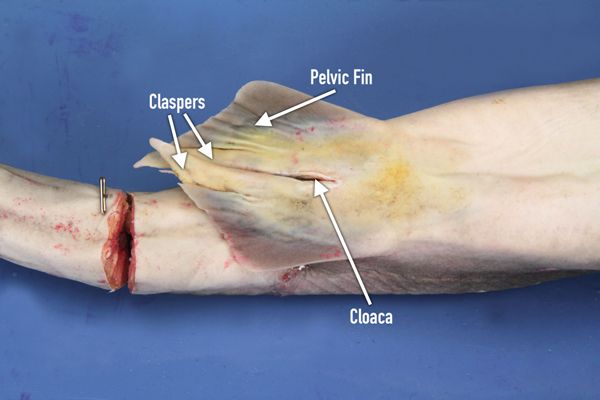The Dogfish Shark—Structure and FUNction!
 Patricia Kopkau
Patricia Kopkau
Anatomy Instructor
Whittemore-Prescott High School
Whittemore, Michigan
Searching for a specimen for your structure and function lab? Look no further than the dogfish.
Students enjoy dogfish dissection, and they remember and refer to the activity long after they perform it. The specimen’s many conspicuous and specialized organs make it ideal for studying structure and function.
Before dissection, ask students to note the various adaptive external structures of the dogfish. Examine the pelvic fins to determine its sex. A male has a long, rigid structure called a clasper on the inside edge of each pelvic fin. The clasper is inserted into the female’s cloaca to transfer sperm during reproduction. Locate the cloaca between the pelvic fins. This is the common opening for the intestine, the urinary tract, and reproductive system.

As they make the first incision from the cloaca to the pectoral girdle, students will notice a tough piece of cartilage between the pectoral fins. Have them speculate about the functions of the pectoral girdle. Then have them remove the structure to reveal the heart. Students should conclude that one function of the pectoral girdle is to protect the heart.
Internally, you will notice the liver—a long, gray, lobed, oily organ. The oil helps to store energy and provides buoyancy. Have students remove the liver and place a piece of it in a container of water. They should be surprised to see that it floats!

Once the liver has been removed, the large central digestive tube will be evident, with the anterior esophagus merging into the stomach. The digestive tube looks uniform on the outside. If you make a midline incision, you will quickly notice a difference on the inside. The fingerlike papillae in the esophagus secrete mucus that aids in moving food to the stomach. The stomach’s longitudinal folds, called rugae, allow the stomach to expand. Discuss these digestive structures in light of the fact that the shark does not chew its food but instead bites off and swallows large chunks of it.

At a J-shaped turn along the digestive tube, the stomach leads into the duodenum. You may be able to find ducts from the pancreas and gallbladder entering at that juncture, where they supply digestive fluids.
The next portion of the intestine shows a characteristic structure of sharks. Ask students what they notice about the structure when examining the intestine from the outside. Have them think about the human small intestine by comparison. Rather than a long, convoluted tube that appears to be packed into its cavity, the shark’s intestine is a short, straight tube with concentric rings around it. Carefully open this portion of the digestive tube, called the valvular intestine, to expose the spiral valve inside. This structure provides maximum surface area over a relatively short distance for efficient absorption of nutrients from food.

Before you reach the cloaca, you will see a slender, fingerlike projection alongside the digestive tube. This is the rectal gland. The rectal gland excretes sodium chloride solution, aiding in osmoregulation of the shark’s bodily fluids. Some other marine animals also have special organs for the elimination of excess salt.
Enjoy using the spiny dogfish shark to put the fun into your study of structure and function!






















